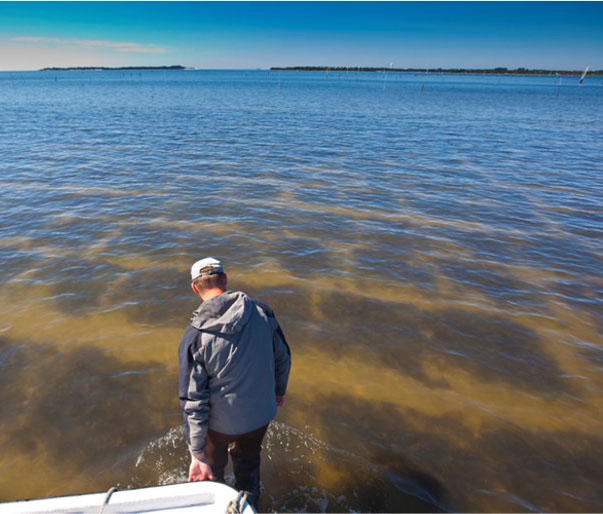Farming of hard clams supports many small businesses in Florida with over 125 million clams produced each year. Farms are located on submerged lands in inshore coastal waters leased from the State of Florida. Florida’s warm climate supports year-round productivity and optimal growing conditions for hard clams. Knowledge of what clams eat and when those food items are available can guide farmers in deciding when to plant seed and harvest clams. Information on the patterns of occurrence of harmful algal blooms, such as toxic red tides, can help farmers avoid or anticipate losses in clam stocks.
Hard clams are bivalve mollusks, animals that feed by filtering suspended particles out of the water column. Particulate material in shallow coastal waters is abundant, and the filtering capacity of bivalves often promotes good water quality. Filter feeding is accomplished by capturing food particles that enter the bivalve shell through water currents or active pumping by the animal. Particles are trapped by gill filaments that contain small hair-like protrusions called “cilia”. The cilia then move the food to the mouth to be digested by the animal. If a particle is too small (<1 µm) it may pass through the filter, but if it is too big (>100-200 µm) it will be rejected as psuedofeces. Organic particles in the correct size range are either plankton, detritus (decaying plant material), or bacteria. Studies have shown that phytoplankton (microscopic algae) are the primary food source of most filter-feeding bivalves. Although most species of phytoplankton are acceptable food items, some produce toxins that can be harmful to hard clams and/or humans that consume them, and some species are inedible due to their physical structure. Phytoplankton can also vary in terms of chemical composition, such as lipid content, which can affect their quality as a food item.

This guide assists farmers in identifying potential food sources for hard clams, the spatial and seasonal distribution of food, as well as whether the food is good (nutritious) or bad (noxious or harmful) for the clams. This guide focuses on two regions of Florida: the Suwannee Sound on the west coast, where clam leases in Dixie and Levy Counties are located, and the Indian River Lagoon on the east coast, encompassing clam leases in Brevard and Indian River Counties.
The following contributed to the development of this guide:
Nikki Dix, Edward Phlips, Shirley Baker, and Susan Badylak
University of Florida, SFRC, Fisheries and Aquatic Sciences Program
Leslie Sturmer, University of Florida, IFAS Extension

If you have any questions about the information provided in this guide, contact the UF/IFAS Shellfish Aquaculture Extension Office, P.O. Box 89, Cedar Key, FL 32625. Phone: (352) 543-5057 E-mail: LNST@ufl.edu
Identification and classification of the marine organisms found in this guide were completed by Susan Badylak and Jean Lockwood, University of Florida. Digital images may not be used without their direct consent. Photo credits: Eric Zamora, Pat Bonish
COPYRIGHT © 2010 FLORIDA SHELLFISH AQUACULTURE EXTENSION, UNIVERSITY OF FLORIDA, ALL RIGHTS RESERVED